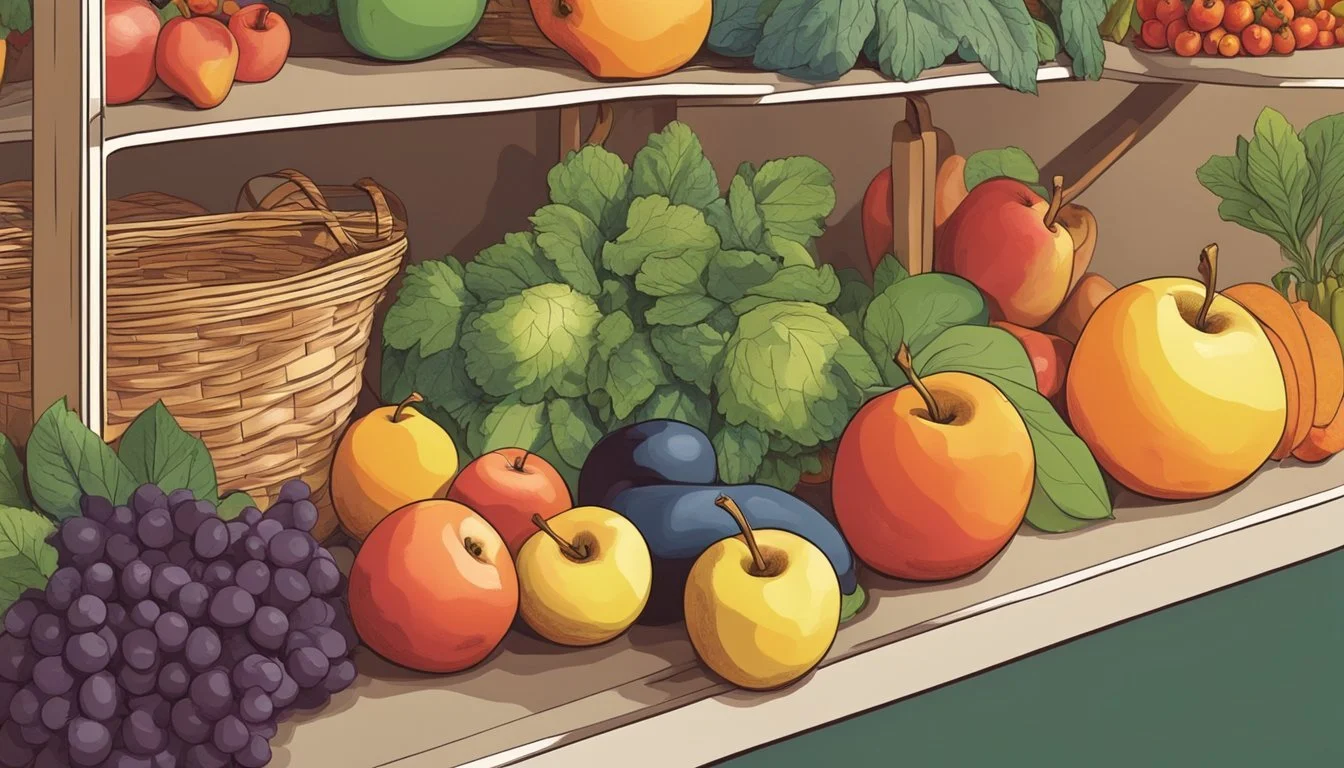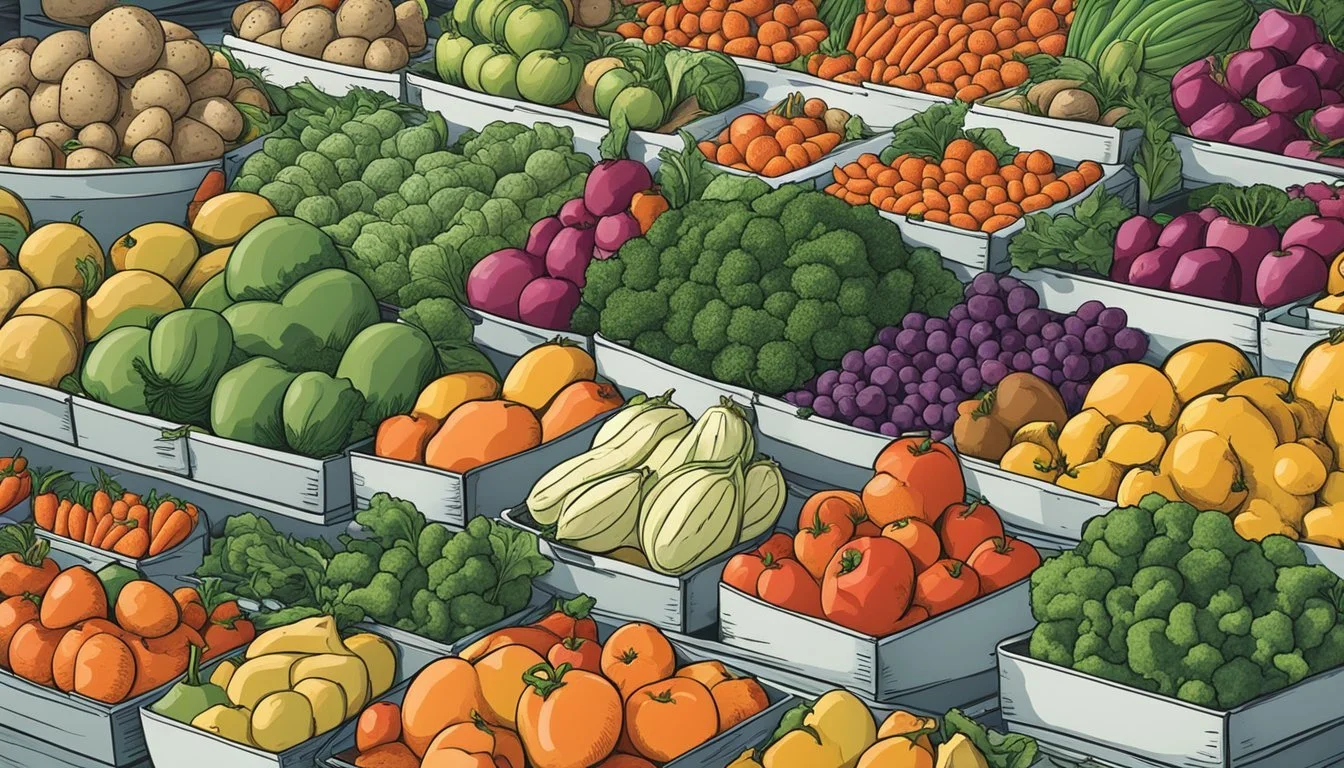Nebraska Seasonal Fruit & Vegetables in February
Your Guide to Winter Produce
This Article is Part of our Nebraska Seasonal Fruit & Veg Calendar
February marks the heart of winter in Nebraska, a time when the landscape rests under frosty blankets and preparations commence for the spring planting season. During this month, local produce is not as abundant as in the warmer months, yet there remains a selection of fruits and vegetables that are accessible due to Nebraska's robust agricultural practices and storage capabilities.
Root vegetables such as potatoes, onions, and carrots are readily available, having been stored effectively post-harvest to ensure they can be enjoyed throughout the winter season. These staples continue to play a crucial role in Nebraskan cuisine, providing the foundation for hearty, warming dishes that are perfect for cold February days.
While it is not the peak time for variety, Nebraska still offers seasonal produce options that not only support local farmers but also promise freshness and flavor. Consumers can find these seasonal offerings at local farmers' markets, which connect growers directly with the community, or at grocery stores that source from regional distributors. This period of lessened bounty is a reminder of the importance of seasonal eating and the natural growth cycles of the local environment.
Seasonal Patterns for Produce
As the Nebraska winter sees its ground covered in frost, local produce follows a distinct seasonal pattern. Choices are limited but one can still find fresh options. They ensure that even in the cold, Nebraskans have access to some of the freshest harvests of the season.
Winter Produce Overview
During February, Nebraska's winter offers a more reserved variety of produce. Residents typically find storage crops and cold-hardy selections that have been harvested in the previous growing season or that thrive in the cooler months. The common winter produce includes:
Root vegetables: beets, carrots, turnips, and parsnips
Storage crops: onions, garlic, winter squash, and potatoes
Hardy greens: kale and collards
Apples: stored from the fall harvest remain crisp
These items make up the core of the local winter diet, and are often seen on dinner tables across the state.
Transitioning to Spring Crops
As Nebraska inches toward spring, one can anticipate the transition in produce offerings. February is the time when preparations for spring planting begin, although the actual harvest of spring crops will not be seen until the subsequent months. Here are the actions taken during late winter:
Seed starting: for crops such as tomatoes and peppers, protected inside greenhouses or homes
Planning: Farmers outline their schedules for planting spring crops such as peas, spinach, and radishes
The weather's gradual warming also signals the land to prepare for the next cycle of growth, with farmers keenly awaiting the shift to spring's bounty.
What's in Season
During February in Nebraska, the selection of seasonal produce includes a variety of hardy vegetables and bright citrus fruits, ensuring a blend of savory and sweet options despite the cold weather.
Vegetables Available in February
Potatoes: A staple root vegetable, potatoes are available and offer a versatile range for cooking methods from baking to mashing.
Onions: Essential for flavoring dishes, onions are in good supply and add depth to winter recipes.
Carrots: Carrots are harvested and known for their sweetness and ability to add color and nutrition to meals.
Cabbage: Cabbage, with its crisp texture, is excellent for hearty stews and slaws.
Leeks: These provide a milder alternative to onions and are great in soups and potato dishes.
Turnips: Often an underestimated root vegetable, turnips can enhance the taste and texture of winter dishes.
Garlic: Widely available, garlic is key for its aromatic qualities and health benefits.
Fruits Available in February
Citrus: Citrus fruits, like lemons, are at their peak, offering a burst of freshness and vitamin C.
Blood Oranges: These are especially sought after for their deep red color and sweet-tart flavor, ideal for salads and dressings.
Selecting and Storing Tips
In Nebraska's February chill, selecting and storing seasonal produce is crucial for maintaining flavor and freshness. By choosing wisely and using proper storage methods, one can enjoy the limited but tasty variety of fruits and vegetables available during this month.
Choosing Fresh Produce
When selecting fresh fruits and vegetables at a grocery store or local market, look for signs of freshness such as firm texture, vibrant color, and the absence of blemishes or soft spots. In February, root vegetables and hardy winter greens are common; they should feel heavy for their size, indicating they are not dehydrated.
Root Vegetables: Seek firm roots with smooth skin.
Winter Greens: Opt for crisp leaves without yellowing.
Proper Storage Methods
Once the produce is home, proper storage is essential to extend its shelf life and preserve its flavor.
Root Vegetables: Store in a cool, dark place with good ventilation. A cellar or cool pantry is ideal. Do not wash before storing as the moisture can promote rot.
Temperature Humidity Storage Location Just above freezing High Cellar/Basement
Winter Greens: Refrigerate in a moisture-proof, airtight container. If the greens are not pre-washed, wrap them in a damp paper towel to maintain humidity.
Temperature Humidity Storage Location 32°F to 36°F (0°C to 2°C) High Vegetable Drawer in Refrigerator
Properly handled, these fruits and vegetables can provide hearty and nutritious meals even in the coldest months.
Health Benefits of Seasonal Eating
Eating seasonally means consuming fruits and vegetables that are naturally harvested at the current time of year. For Nebraska residents in February, this could include storage crops like potatoes and onions, as well as hearty greens from indoor growing systems or high tunnels.
Nutritional Advantages: Seasonal produce is often at its peak in both flavor and nutritional value. Fruits and vegetables contain the most vitamins and minerals when they are harvested at the right time. For example, leafy greens grown and consumed in their appropriate season may have a higher concentration of nutrients important for reducing the risk of chronic diseases.
Freshness: Seasonal fruits and vegetables are typically fresher, as they have traveled shorter distances and have been picked at their optimum ripeness.
Variety: Seasonal eating encourages a diverse diet, often introducing consumers to new produce items they might not otherwise encounter, which can lead to broader nutritional benefits.
Enhanced Flavor: Foods grown in season tend to have more flavor. Since they are picked when they’re naturally ripe, the produce is more flavorful, and this can lead to higher satisfaction with meals without the need for added sugars or flavor enhancers.
Seasonal Produce Expected Benefits Hearty Greens Rich in fiber, vitamins A, C, K, and iron Storage Vegetables Long-lasting energy, vitamin C, B6
Consuming seasonal produce not only supports the body's nutritional needs but also aligns with natural cycles, which can have positive environmental impacts by reducing the distances food travels. This supports local agriculture, reduces carbon footprints, and often results in a more sustainable way of eating.
Recipes and Preparation
In Nebraska, February calls for creativity in the kitchen with a variety of seasonal produce. These fruits and vegetables are prime for a range of cooking methods that enhance their natural flavors.
Cooking with Seasonal Produce
Recipes often highlight the essence of seasonal ingredients. Winter in Nebraska sees root vegetables and hearty greens take center stage. Root vegetables like turnips and carrots can be roasted to bring out a deeper, sweeter flavor profile. To roast, one simply needs to chop these vegetables into even pieces, coat them with olive oil and their favorite herbs, and bake at a high temperature until tender and lightly caramelized.
Leafy greens such as kale and spinach are abundant and can be used in both raw and cooked applications. They can be incorporated into savory dishes like stews and soups, adding nutritional value and a burst of color. For a simple preparation, one might sauté greens with garlic and olive oil for a side dish that complements almost any main course.
Citrus fruits, available at this time, offer bright flavors that contrast the earthiness of root vegetables. They can be squeezed into dressings and marinades, adding a fresh zing that can brighten up winter dishes. Chefs might also candy citrus peels to create a sweet treat that utilizes the whole fruit, reducing waste.
When preparing these fruits and vegetables, remember that simplicity often allows their natural flavors to shine through. Experiment with different combinations, like adding blood orange segments to a salad of mixed greens, to appreciate the full palette of flavors that Nebraska’s seasonal produce has to offer.
Shopping for Produce
In February, shoppers in Nebraska have reliable venues for seasonal produce, namely local farmers markets and grocery stores. These locations may vary in offered variety, but each boasts its own advantages in terms of freshness, availability, and supporting local entities.
Finding Local Farmers Markets
Local farmers markets are treasure troves of seasonal produce, often with a bounty of fresh vegetables and fruits straight from Nebraska's farmlands. They are ideal places for consumers to support regional farmers directly. During February, expect to find cool-season crops such as kale and a selection of root vegetables. Here one can engage with growers, gaining insights into the produce's journey from field to table.
Availability: Products may be limited to what can be grown locally during the winter months.
Variety: Emphasis on root vegetables, winter greens, and stored produce from the previous harvest.
Grocery Store Selections
Grocery stores, on the other hand, provide a diverse selection of produce, including items that are not in season locally due to imports from other regions. Consumers have the convenience of finding seasonal and non-seasonal produce all in one place.
Availability: Wider availability that includes both local and non-local produce.
Variety: Extended variety, featuring out-of-season items alongside in-season produce.
Grocery stores work with a network of suppliers to ensure a steady supply, making seasonal and off-season produce available to shoppers throughout the year. They also provide the benefit of consistent operating hours, unlike some farmers markets which may have shorter winter schedules or run only on specific days of the week.
Agriculture and Economy
Nebraska's economy has deep roots in agriculture, with a significant portion driven by the state's capacity to produce a wide variety of fruits and vegetables. This agricultural prowess not only supports the livelihood of local farmers but also bolsters the state’s overall financial well-being.
Impact of Produce on Nebraska Economy
In Nebraska, the sale of produce contributes considerably to the state's financial health. Farming is a cornerstone of the Nebraska economy, with the state's farmers playing a pivotal role in both local and national markets. The cultivation and sale of fruits and vegetables provide a steady source of income for these farmers, which is then reinvested into the community, fostering economic growth.
Direct Impact: Revenue generated from the sale of crops aids in the sustenance of the farming community and supports the state's infrastructure, resulting in a thriving local economy.
Indirect Impact: When farmers prosper, there is a positive ripple effect on subsidiary industries, ranging from equipment suppliers to food processors, further solidifying the economic significance of agriculture in Nebraska.
In February, while the range of locally grown produce is limited due to the cold climate, the state’s economy still benefits from the year-round agricultural activities. These include the selling of stored crops from previous seasons and the preparation for the coming planting season. The ability to manage and market these crops efficiently is crucial to maintaining economic stability and growth year-round.









